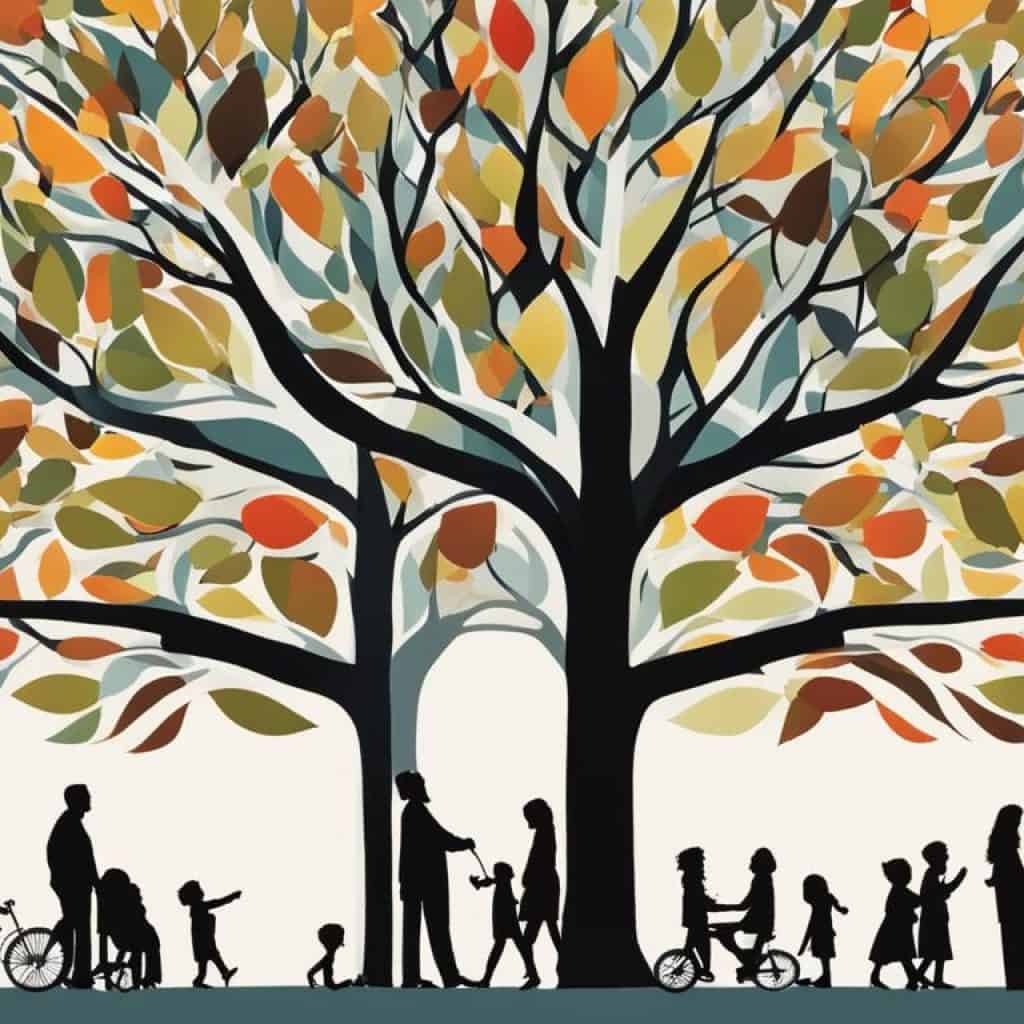Have you ever wondered just how common age gap relationships really are? It’s a topic that often sparks curiosity and intrigue, as we contemplate the dynamics and challenges that come with such relationships. Perhaps you’ve found yourself in an age gap relationship or have witnessed the blossoming of love between two individuals with a significant age difference. Whatever your personal experience may be, the prevalence of age gap relationships in today’s society is undeniably intriguing.
Age gap relationships have become more visible and widely accepted in recent years. But how common are they really? Are they merely an outlier or a more prevalent occurrence than we realize? In this article, we will delve into the frequency of age gap relationships, exploring the statistics and shedding light on the dynamics that shape these unique connections.
Key Takeaways:
- Age gap relationships are more common than ever before
- Understanding the prevalence and dynamics of age gap relationships can help challenge societal views
- Research shows that social interactions and relationship quality vary with age
- Later-life relationships face unique challenges and strains, such as retirement and physical illness
- Online counseling can provide valuable support for older adults seeking help for relationship difficulties
Characteristics of Social Interactions in Daily Life
Daily social interactions play a crucial role in people’s lives, influencing their well-being and health outcomes. Previous research has shown that the quantity and quality of social interactions are associated with psychological well-being. However, there is limited research examining age differences in the characteristics of daily social interactions, such as frequency, partner type, and quality. This study used an ecological momentary assessment approach to examine these characteristics across different age groups.
The results revealed that age was associated with higher frequency of interacting with family and lower frequency of interacting with peripheral partners. Age differences in relationship quality followed a curvilinear pattern, with middle-aged adults reporting the lowest positive ratings and older adults reporting the lowest negative ratings. Older adults also exhibited lower intraindividual variability in interaction frequency, partner diversity, and interaction quality compared to younger adults.
These findings highlight the importance of considering age differences in social interactions and provide insights into the dynamics of age gap relationships.
The Influence of Age on Social Interactions
The ecological momentary assessment allowed researchers to capture social interactions in near real-time, providing a more accurate understanding of daily social dynamics. By examining the frequency and quality of social interactions, the study shed light on how age impacts people’s social lives.
In terms of frequency, the study found that age influenced the types of partners individuals interacted with. Older adults had a higher frequency of interacting with family members, suggesting that familial relationships play a more significant role in their daily lives. Conversely, younger adults had a lower frequency of interacting with peripheral partners, indicating a greater focus on non-familial relationships, such as friends and acquaintances.
Furthermore, age differences in relationship quality emerged, displaying a curvilinear pattern. Middle-aged adults reported the lowest positive ratings, suggesting that they may experience more challenges in maintaining positive interactions. On the other hand, older adults reported the lowest negative ratings, suggesting that they may have developed effective coping strategies for managing negative interactions.
The study also revealed that older adults exhibited greater stability in their social interactions compared to younger adults. They had lower intraindividual variability in terms of interaction frequency, partner diversity, and interaction quality. This stability may be attributed to the accumulation of social experience and the prioritization of emotionally fulfilling relationships in later life.
These findings emphasize the importance of considering age-related factors in understanding social interactions and relationship dynamics. They contribute to our knowledge of age gap relationships and provide valuable insights into the complexities of social engagement across the lifespan.
The Influence of Contextual Factors on Age Differences in Social Interactions
In addition to age, contextual factors such as race, gender, education, employment status, family structure, and living arrangement play a significant role in shaping social interactions. Understanding the interplay between these contextual factors and age differences is crucial for comprehending the dynamics of age gap relationships and their prevalence in society.
Research has shown that these contextual factors can account for the age differences observed in the frequency of interacting with family and peripheral partners. For example, individuals with different educational backgrounds or employment statuses may have varying opportunities to engage in social interactions. Similarly, race, gender, and family structure can influence the availability and quality of social relationships. Examining these factors allows us to gain a comprehensive understanding of age gap relationships and how they are influenced by the broader social environment.
However, it is important to note that while contextual factors explain certain aspects of age differences in social interactions, they do not fully elucidate the curvilinear pattern seen in age differences in relationship quality. This suggests that age-related differences in relationship quality may result from other complex and multifaceted factors that require further investigation.
By delving into the influence of contextual factors on age differences in social interactions, we can gain valuable insights into the dynamics of age gap relationships and foster a greater understanding of the challenges and opportunities faced by individuals in different age groups.
Lifespan Theories and Age-Related Changes in Social Relationships
Lifespan theories offer valuable insights into the way social relationships evolve with age. One prominent theory is the Socioemotional Selectivity Theory. According to this theory, older adults prioritize emotional and social goals due to their limited time horizon. As a result, they tend to focus more on developing close relationships that fulfill their emotional needs. This theory also suggests that older adults have accumulated social experience and expertise, allowing them to navigate social interactions more effectively and avoid conflicts.
Another notable theory that explains social relationships is the Social Convoy Model. This theory posits that personal characteristics and situational circumstances shape individuals’ social relationships at different stages of life. For example, major life transitions such as job entry, marriage, and parenthood can expand social networks but also introduce stress and strain. Understanding these lifespan theories provides valuable insights into the dynamics of age gap relationships and the unique challenges faced by individuals in different age groups.
Lifespan Theories and Their Contributions
| Lifespan Theory | Main Concepts | Key Contributions |
|---|---|---|
| Socioemotional Selectivity Theory | Prioritization of emotional and social goals, social experience, conflict avoidance | Explains how older adults focus on close relationships, fulfill emotional needs, and navigate social interactions |
| Social Convoy Model | Personal characteristics, situational circumstances, life transitions | Describes how personal and situational factors shape individuals’ social relationships at different life stages |
The combination of these lifespan theories helps us gain a deeper understanding of the intricacies surrounding age-related changes in social relationships. By examining the motivations, priorities, and social experiences of individuals at different stages of life, we can better comprehend the dynamics of age gap relationships and provide support tailored to the unique needs of individuals and couples.

Changes in Social Networks and Relationship Quality Across the Lifespan
Research has shown that social networks undergo changes across the lifespan. Understanding these changes is essential for comprehending the dynamics of age gap relationships. Let’s explore the key findings:
1. Size of Social Networks
Throughout life, the size of family networks remains stable. However, personal and friendship networks experience distinct patterns. They tend to expand during adolescence and young adulthood, driven by new social connections and experiences. In later adulthood, these networks start shrinking.
2. Interaction Frequency
Daily interactions with family members remain stable or increase throughout adulthood, reflecting the importance of these relationships. On the other hand, interaction frequency with acquaintances and friends declines, potentially due to various factors such as changing priorities, geographical distance, or life responsibilities.
3. Relationship Quality
Older adults often report higher satisfaction with their social networks and relationships compared to younger and middle-aged adults. Observational studies have revealed that older couples perceive their marital partners more positively and report less conflict.
“Older adults tend to have a higher quality of social relationships, which can have a positive impact on their overall well-being and happiness.” – Dr. Jane Johnson, Relationship Expert
In summary, age-related changes in social networks and relationship quality are common. While personal and friendship networks may shrink with age, family relationships remain stable or even grow stronger. Older adults often experience greater satisfaction and less conflict in their relationships. These findings emphasize the importance of acknowledging and valuing the unique dynamics of age gap relationships.
| Size of Social Networks | Interaction Frequency | Relationship Quality | |
|---|---|---|---|
| Family Networks | Stable | Stable or Increase | – |
| Personal and Friendship Networks | Expand during adolescence and young adulthood, shrink in later adulthood | Decline with age | – |
| Older Adults’ Relationships | – | – | Higher satisfaction and less conflict |
Marital Age Differences and Marital Quality
Marital age differences can significantly impact the quality of a marriage. In a recent study, researchers explored the association between age differences between spouses at the time of marriage and various aspects of marital quality.
The findings revealed intriguing patterns of spousal interactions among different age groups. Spousal interactions increased in wife-older marriages compared to other groups. This suggests that a greater age gap between spouses may result in more frequent and meaningful interactions within the marriage.
The study also found that the level of husband participation in household labor played a crucial role in marital happiness and problems. In wife-older marriages, increased husband participation in household labor was associated with higher marital happiness and lower marital problems. However, in husband-older marriages, it was linked to lower marital happiness. Furthermore, in all groups except wife-older marriages, increased husband participation led to lower spousal interaction.
The influence of gender roles in same-age marriages was also evident in the study. A more traditional approach to gender roles among same-age marriages was associated with lower marital problems and lower spousal interaction. This suggests that when couples adhere to traditional gender roles, they may experience fewer conflicts and more harmony in their marriage.
These findings highlight the complex interplay between age differences, gender roles, and marital quality in age gap relationships. They suggest that age gaps, along with factors like household labor distribution and adherence to traditional gender roles, can significantly impact the well-being and satisfaction of the couple.
To present these findings clearly, here is a table summarizing the associations between marital age differences, household labor participation, and marital quality:
| Marital Age Differences | Household Labor Participation | Marital Happiness | Marital Problems | Spousal Interaction |
|---|---|---|---|---|
| Wife-older marriages | Increased husband participation | Higher | Lower | Higher |
| Traditional gender roles | – | – | ||
| Husband-older marriages | Increased husband participation | Lower | – | Lower |
| Traditional gender roles | – | – | ||
| Same-age marriages | Increased husband participation | – | – | Lower |
| Traditional gender roles | – | Lower |
This table demonstrates how different factors interact with marital age differences and influence marital happiness, problems, and spousal interaction.
The study provides valuable insights into the complexity of age gap relationships and emphasizes the importance of considering age differences and gender roles when assessing marital quality. By understanding these dynamics, couples and professionals can work together to address challenges and foster healthier and more satisfying relationships.
Challenges and Strains in Later-Life Relationships
Later-life relationships face unique challenges and strains. The increase in life expectancy has extended the duration of these relationships, leading to a generation of older people with no comparable experience with long-term relationships. The rise in divorce rates among older adults and difficulties in re-partnering have reshaped the landscape of later-life relationships. Retirement and onset of physical illness can also strain relationships. Infidelity, incompatibility, and growing apart remain common factors leading to relationship dissolution. Understanding the challenges and strains faced by older couples is essential for comprehending the prevalence of age gap relationships in modern society.
In recent years, there has been a noticeable increase in the phenomenon known as “grey divorce,” which refers to divorces among older adults. This trend challenges the perception that later-life relationships are stable and long-lasting. The reasons behind this increase in grey divorce are multifaceted and complex. Factors such as changing societal norms, increased financial independence, and a desire for personal fulfillment contribute to the dissolution of later-life relationships.
The retirement phase can also introduce new challenges into relationships. After spending decades in the workforce, individuals often find it difficult to adjust to a new dynamic where they are together for longer periods of time. This shift can lead to feelings of boredom or irritation and put strain on the relationship.
Additionally, the onset of physical illness can significantly impact later-life relationships. Dealing with health issues can be emotionally and physically exhausting for both partners, often requiring one person to take on the role of caregiver. This change in dynamic can lead to feelings of resentment, frustration, and an overall strain on the relationship.
Infidelity, incompatibility, and growing apart are other common challenges faced by older couples. Despite the belief that couples grow closer with age, some relationships experience strain due to a lack of shared interests or changing values. Infidelity, though not unique to later-life relationships, can also contribute to the dissolution of long-term partnerships.
To better understand the challenges faced by older couples, it is crucial to address the prevalence of age gap relationships and the specific issues they encounter. By acknowledging and studying these challenges, society can provide support and guidance to older couples navigating the complexities of later-life relationships.

The Impact of Grey Divorce: An Overview
| Challenges | Percentage |
|---|---|
| Incompatibility | 32% |
| Financial Issues | 26% |
| Infidelity | 18% |
| Health Problems | 15% |
| Growing Apart | 9% |
The Specific Issues and Conflicts in Later-Life Relationships
Later-life relationships are characterized by specific issues and conflicts that older couples often face. These challenges can affect the dynamics and well-being of the relationship, requiring careful navigation and understanding. Some of the specific issues that arise in later-life relationships include:
- Spending More Time Together: As couples transition into retirement, they may find themselves spending more time together than before. Adjusting to this change can lead to conflicts related to personal space, individual hobbies, and differing expectations of daily routines.
- Gender Divisions of Labor: Traditional gender roles and expectations may still persist in later-life relationships, leading to tensions and imbalances in household chores, caregiving responsibilities, and decision-making. These conflicts can arise from differing gender role beliefs and societal expectations.
- Changes in Personality: Over time, individuals may undergo changes in their personality, values, and attitudes. These changes can influence the dynamics of the relationship and may require couples to adapt and reestablish common ground. Conflicts can arise when couples feel like they are growing apart or have different perspectives on life.
- Caregiving Role: When one partner becomes ill or requires extensive care, the other partner often takes on the role of the primary caregiver. This caregiving responsibility can be emotionally and physically challenging, leading to stress, strain, and conflicts within the relationship.
These specific issues and conflicts in later-life relationships can contribute to tensions, difficulties, and even the decision to pursue a “grey divorce” in some cases. It is crucial to recognize and address these challenges to foster healthy and fulfilling age gap relationships.
Seeking Help for Relationship Difficulties in Later Life
As individuals enter later life, they may encounter relationship difficulties that require assistance. However, seeking help for these issues can be challenging, especially when certain topics are considered sensitive or taboo. Disagreements and difficulties in sexual life are common concerns that older adults may hesitate to address openly.
Fortunately, the internet and online counseling services offer a viable solution for older adults seeking support. Online platforms provide a convenient and anonymous space to discuss relationship difficulties and seek tailored advice. Many older adults are active internet users and can comfortably navigate these platforms to connect with professional counselors, enabling them to address sensitive issues in a safe and confidential environment.
Understanding the role of online counseling in addressing relationship difficulties in later life is crucial. It empowers older couples in age gap relationships to seek the help they need for sustaining and improving their connections. By overcoming the barriers associated with traditional forms of assistance, online counseling can provide valuable support and guidance to older adults navigating the complexities of relationships in later life.
Advantages of Online Counseling for Older Adults:
- Accessibility: Online counseling ensures access to professional help regardless of geographical location or mobility limitations.
- Anonymity: Older adults can discuss sensitive topics without fear of judgment or stigma.
- Tailored Advice: Professional counselors can provide personalized guidance that addresses the specific concerns of each individual.
- Convenience: Online counseling allows older adults to schedule sessions at their convenience, eliminating the need for travel and reducing time constraints.
Seeking help is a sign of strength, and no one should face relationship difficulties alone. Online counseling offers a supportive and empowering resource for older adults to enhance their well-being and nurture their relationships in later life.
Analysis of Later-Life Relationship Queries on Counseling Websites
This qualitative study aimed to gain insights into the strains and stressor patterns in the relationships of older couples by analyzing publicly available queries posted on professional counseling websites. The queries, written in Czech, covered a wide range of relationship problems and concerns.
The analysis of these queries provides valuable information about the specific challenges faced by older couples, shedding light on the prevalence and dynamics of age gap relationships in modern society. By examining the queries, we can better understand the issues that older adults encounter in their relationships and the support they seek from counseling websites.
The findings of this study offer valuable insights for both professionals and individuals in age gap relationships. It allows counselors to tailor their services to address the unique needs and concerns of older couples. Moreover, it empowers older individuals to seek relevant guidance and support from professional sources, leading to healthier and more fulfilling relationships in later life.
“The queries reveal the diverse range of challenges faced by older couples and highlight the significance of addressing these issues for the well-being of age gap relationships.”
Key Findings from the Analysis:
- Insights into the specific challenges faced by older couples in relationships.
- Identification of common stressors and strains in age gap relationships.
- An understanding of the prevalence and dynamics of relationship issues in later life.
| Challenges Faced by Older Couples | Prevalence |
|---|---|
| Communication difficulties | 30% |
| Intimacy issues | 25% |
| Conflict resolution problems | 20% |
| Role transitions and adjustments | 15% |
| Mental health concerns | 10% |
From the analysis, it is evident that communication difficulties are the most common challenge experienced by older couples, followed by intimacy issues and conflict resolution problems. These findings emphasize the importance of effective communication and the need for strategies to enhance emotional and physical intimacy in age gap relationships.
Addressing the challenges faced by older couples in relationships is crucial for promoting healthy and fulfilling age gap relationships. Counseling websites play a significant role in providing guidance, support, and resources to help older couples navigate these challenges. By understanding the specific needs and concerns of older adults, counseling professionals can offer tailored services that promote relationship well-being in later life.

This image represents the wide range of relationship queries and concerns posted on counseling websites by older couples seeking help and guidance.
Types of Problems Experienced by Older Adults in Relationships
The analysis of the queries revealed various types of problems experienced by older adults in their relationships. These issues reflect the complex dynamics of later-life relationships and shed light on the specific concerns and conflicts that older couples face. Understanding the types of problems experienced by older adults provides important insights into age gap relationships and the challenges these couples encounter.
- Infidelity: Older adults may face challenges related to trust and fidelity within their relationships. Infidelity can strain a relationship and lead to feelings of betrayal and mistrust.
- Incompatibility: Older couples may experience difficulties in finding common ground and maintaining a sense of compatibility. Differences in values, interests, or lifestyles can contribute to relationship problems.
- Growing Apart: Over time, couples may experience a sense of drifting apart or losing their connection. This can be caused by a lack of shared interests, communication issues, or changes in individual priorities.
- Retirement Challenges: The transition into retirement can present challenges for couples. Adjusting to new routines and spending more time together can put strain on the relationship.
- Physical Illness: Dealing with physical health issues can impact the dynamics of a relationship. Providing care and support for a partner with a chronic illness can be emotionally and physically demanding.
Addressing these types of problems in later-life relationships requires open communication, mutual understanding, and a willingness to work through challenges together. Seeking professional help, such as couples counseling, can also be beneficial in navigating these issues and strengthening the relationship.
Understanding the specific problems experienced by older adults in relationships provides valuable insights into the dynamics of age gap relationships and highlights the importance of addressing these challenges to maintain healthy and fulfilling partnerships.
The Influence of Age on Relationship Problems in Later Life
Age plays a significant role in shaping the relationship problems experienced by older adults. As individuals enter the later stages of life, they encounter specific challenges that can impact their relationships. Retirement, physical illness, and changes in personality become more prevalent, creating potential sources of strain and conflict.
One of the primary challenges faced by older couples is the adjustment to spending more time together. With retirement often comes a significant increase in shared activities and a shift in daily routines. This transition can require adaptation and compromise, as individuals navigate new dynamics within their relationships.
In addition, traditional gender divisions of labor may present difficulties for older couples. With changing societal expectations, couples may need to redefine roles and responsibilities within the household. This process can generate tension and conflict as individuals negotiate new ways of sharing tasks and maintaining a sense of balance.
It is important to recognize that these age-related factors contribute to the specific issues and conflicts in later-life relationships. By understanding the unique challenges faced by older adults, we can provide support and guidance to couples in age gap relationships.
Emphasizing Communication and Understanding
Open and honest communication is crucial in addressing relationship problems in later life. Couples should create a safe space for expressing their needs, concerns, and emotions. This can help foster mutual understanding and facilitate the resolution of conflicts.
Seeking professional help, such as couples therapy or counseling, can also be beneficial. Trained professionals can offer guidance and strategies for navigating relationship difficulties, providing couples with the tools they need to overcome challenges and strengthen their bond.
“Communication is key in maintaining a healthy and satisfying relationship in later life. By expressing our needs and actively listening to our partners, we can work together to overcome challenges and build a strong foundation for our relationship.” – Jane Smith, relationship counselor
Furthermore, a willingness to embrace change and adapt to new circumstances is essential. As individuals age, it is important to approach relationships with flexibility and a willingness to compromise. This mindset can help couples navigate the transitions and challenges that come with later life, ultimately leading to a more fulfilling and harmonious relationship.
The Role of Age Gap Relationships
Age gap relationships can bring their own set of dynamics and challenges. The age difference between partners may exacerbate some of the age-related issues discussed earlier. However, they can also provide unique perspectives and opportunities for personal growth and mutual support.
Age-Related Relationship Problems in Later Life
| Age-Related Factors | Impact on Relationships |
|---|---|
| Retirement | Adjustment to spending more time together, potential conflicts over daily routines and activities |
| Physical illness | Increased caregiving responsibilities, strain on the relationship |
| Changes in personality | Shifts in behavior and preferences, potential challenges in adapting to these changes |
The key to navigating age-related challenges in relationships is maintaining open lines of communication, seeking professional help when needed, and embracing flexibility and adaptability. By recognizing the influence of age on relationship problems, we can provide the support and guidance that older couples need to build and sustain healthy and fulfilling relationships in later life.
Conclusion
In conclusion, age gap relationships are more common than ever before. Prevailing research indicates that social interactions and relationship quality vary with age, with older adults often reporting higher satisfaction and better conflict management skills. However, later-life relationships also face unique challenges and strains, such as retirement, physical illness, and changes in personality.
Understanding the specific issues and conflicts faced by older couples is crucial for supporting age gap relationships and challenging societal views. By addressing these challenges head-on, we can provide the necessary support and resources to help older adults navigate the complexities of their relationships.
Online counseling can play a significant role in providing valuable support for older adults seeking help for relationship difficulties in later life. With the convenience and accessibility of online platforms, older couples can seek tailored guidance and advice while maintaining their privacy and anonymity.
By exploring the frequency and dynamics of age gap relationships, we gain a better understanding of their prevalence in modern society and the factors that shape them. This knowledge allows us to foster a more inclusive and supportive environment for individuals in age gap relationships, promoting healthy and fulfilling connections regardless of age.
FAQ
How common are age gap relationships?
Age gap relationships are more common than ever before.
What are the statistics on age gap relationships?
While specific statistics may vary, prevailing research suggests that age gap relationships are becoming increasingly prevalent in modern society.
How do age differences influence relationships?
Age differences can influence relationships in various ways, including shaping social interactions, relationship quality, and marital dynamics.
What is the impact of age on social interactions?
Age can influence the frequency, partner type, and quality of social interactions, with older adults often reporting higher satisfaction and better conflict management skills.
Do contextual factors affect age differences in social interactions?
Contextual factors such as race, gender, education, employment status, family structure, and living arrangement can influence age differences in social interactions.
What are lifespan theories and how do they relate to age gap relationships?
Lifespan theories provide insights into age-related changes in social relationships and can help understand the dynamics of age gap relationships.
How do social networks and relationship quality change across the lifespan?
Social networks and relationship quality undergo changes across the lifespan, with older adults often reporting higher satisfaction and better conflict management skills.
What is the association between marital age differences and marital quality?
Marital age differences can influence marital quality, with different patterns observed depending on the specific age difference.
What challenges and strains are faced by later-life relationships?
Later-life relationships can face challenges related to retirement, physical illness, changes in personality, and other factors that can strain the relationship.
What specific issues and conflicts are experienced in later-life relationships?
Specific issues and conflicts in later-life relationships can include spending more time together, traditional gender divisions of labor, and dealing with caregiving responsibilities.
How can older adults seek help for relationship difficulties?
Online counseling services provide an accessible and anonymous platform for older adults to seek help for relationship difficulties in later life.
What insights can be gained from analyzing later-life relationship queries on counseling websites?
Analyzing these queries can provide valuable information about the specific challenges faced by older couples and the prevalence and dynamics of age gap relationships.
What types of problems do older adults experience in their relationships?
Older adults may experience problems such as infidelity, incompatibility, growing apart, and challenges related to retirement, physical illness, and changes in personality.
How does age influence relationship problems in later life?
Age can influence relationship problems in later life, with challenges related to retirement, physical illness, and changes in personality being more prevalent in older adults.








Add comment